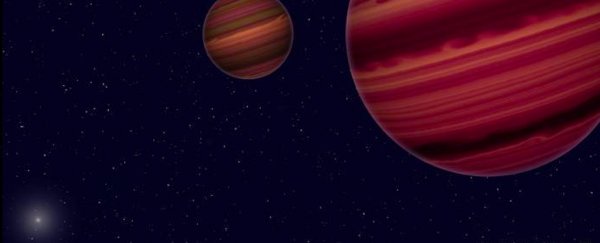The line between star and planet might be a lot finer than we think.
Brown dwarfs are celestial objects that are more massive than a planet, but not quite massive enough to be stars. But astronomers have discovered two brown dwarfs that are so massive they're challenging our understanding of star evolution.
They're called Epsilon Indi B and C, and with new estimates putting them at more than 70 times the mass of Jupiter, they're seriously close to making the big time as stars.
But their dull luminosity suggests they're definitely not stars as yet, and it's forced astronomers to reconsider exactly how heavy an object has to be in order for it to spark up with nuclear fusion.
Brown dwarfs are typically described as failed stars, falling short of possessing the material necessary for gravity to put the big squeeze on atoms of hydrogen and ignite a nuclear furnace.
Currently, brown dwarfs are thought to have an upper limit of around 70 Jupiter masses. Beyond that and there's every chance they'll start to shine.
But this discovery suggests that might not be the case.
Discovered back in 2003 inside the Indus constellation, roughly 12 light-years away, the Epsilon Indi system consists of a small main sequence star about three quarters the mass of our own Sun, and a pair of brown dwarfs.
Even more recently a Jupiter-sized object was found orbiting the star, which is currently the nearest exoplanet of its kind to our own Solar System.
Astronomers had previously calculated the masses of the largest three objects making up the system based on the amount of light they emitted.
Those initial observations based on infra-red imaging and low-resolution spectroscopy predicted the brown dwarfs' masses would be roughly 47 and 28 Jupiter masses, give or take about 25 percent.
But researchers from the Carnegie Institution for Science in Washington DC took a slightly different approach this time, watching them wiggle instead.
In this new attempt, researchers used data from two long term studies – the Carnegie Astrometric Planet Search, and the Cerro Tololo Inter-American Observatory Parallax Investigation by the Research Consortium of Nearby Stars.
By mapping the smallest movements of the objects against their cosmic background, they were able to come up with a more precise measurement of the two brown dwarf masses. And it seems initial predictions were a little off.
Epsilon Indi B is now thought to be around 75 times the mass of our own king of planets, plus or minus 0.82 Jupiters.
For Epsilon Indi C, that Jupiter-equivalent bulk is closer to 70.1, with some wiggle room of 0.68 masses.
Those masses are, of course, above that current 70 Jupiter mass limit scientists generally put on brown dwarfs.
Putting an exact number to that magic limit is no simple matter, though. Last year a beefy body roughly 90 times the mass of Jupiter was reclassified from a relatively cool red dwarf star to a warm brown dwarf wannabe.
The big question is whether this rare object is representative of an actual limit or some kind of anomaly. As it was, that super-sized goliath SDSS J0104+1535 also stood out for its pristine mix of hydrogen and helium.
Nature is never neat and tidy, so any useful model on stellar evolution would require ample observations to build up a clear picture, taking into account their evolution and composition.
"Taken together, our results mean that the existing models need to be revised," says the study's first author Serge Dieterich.
In addition to working out the masses of the two brown dwarfs, the researchers proposed various scenarios describing the lives of these massive sub-stellar objects in the hope of producing better models for predicting their evolution.
With these new discoveries, that margin surrounding a tipping point is looking thinner than ever.
"We showed that the heaviest brown dwarfs and the lightest stars may only have slight differences in mass," says Dieterich.
"But despite this, they are destined for different lives – one racing to dim and cool, the other shining for billions of years."
Brown dwarfs are notoriously hard to spot, resembling yesterday's smouldering coals in a field of blazing bonfires.
Yet knowing just how common these kinds of dark solar systems are could tell us a great deal about the possibility of life in the cosmos.
"We are interested in whether stars and brown dwarfs always exist in the same proportion to each other in star-forming regions, which could help us understand the overall habitability of our galaxy," says one of the researchers Alycia Weinberger.
We really did have such high hopes for these underachieving suns. They came so close, yet still had so far to go.
This research was published in The Astrophysical Journal (link down at the time of writing, but you can read the pre-print on arXiv here).
